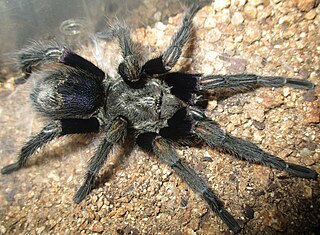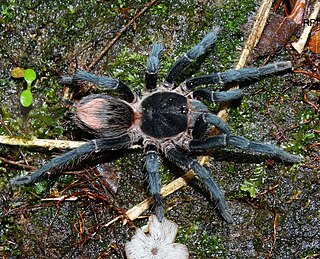
Euathlus is a genus of South American tarantulas that was first described by Anton Ausserer in 1875. These spiders are medium sized and are usually found in high elevations in the Andes. It is a senior synonym of Paraphysa, and was formerly considered a senior synonym of Brachypelma, but this was later rejected.

Tarantulas comprise a group of large and often hairy spiders of the family Theraphosidae. As of December 2023, 1,100 species have been identified, with 166 genera. The term "tarantula" is usually used to describe members of the family Theraphosidae, although many other members of the same infraorder (Mygalomorphae) are commonly referred to as "tarantulas" or "false tarantulas". Some of the more common species have become popular in the exotic pet trade. Many New World species kept as pets have setae known as urticating hairs that can cause irritation to the skin, and in extreme cases, cause damage to the eyes.

Neischnocolus is a genus of spiders in the family Theraphosidae. It was first described in 1925 by Petrunkevitch. The genus Ami was separately described in 2008, but was later discovered to be a junior synonym of Neischnocolus. Species are native to Central America and northern South America.
Cyclosternum is a genus of tarantulas that was first described by Anton Ausserer in 1871.

The Theraphosinae are a large subfamily of Mygalomorphae spiders in the family Theraphosidae found in the Neotropical realm.
Sickius is a genus of tarantulas. It has a single species, Sickius longibulbi. It is endemic to Brazil.
Hapalotremus martinorum is a species of tarantula in the subfamily Theraphosinae native to the High Yungas of Salta province, Argentina. It was first described in a 2015 publication by Patricio E. Cavallo and Nelson Ferretti.
Tmesiphantes aridai is a species of tarantula in the family Theraphosidae, subfamily Theraphosinae. The type locality is Floresta Nacional do Tapajós, Santarém, in the state of Pará, Brazil.
Hapalotremus is a genus of South American tarantulas in the Theraphosinae subfamily that was first described by Eugène Louis Simon in 1903. They have red or white Type III urticating hairs, up to 1.2 millimetres (0.047 in), with a fine point and barbs along at least half of the lower part. The tibial apophysis is branched twice, and there is a conspicuous subapical keel on the male's embolus.
Tmesiphantes uru is a species of tarantula in the subfamily Theraphosinae. It is endemic to Argentina.
Tmesiphantes mutquina is a species of theraphosid spider in the subfamily Theraphosinae. It is native to Argentina.
Tmesiphantes crassifemur is a species of theraphosine theraphosid spider. It is native to Argentina.
Tmesiphantes is a genus of Brazilian tarantulas in the subfamily Theraphosinae that was first described by Eugène Louis Simon in 1892. The genera Magulla and Melloleitaoina were brought into synonymy in 2019.

Kankuamo marquezi is the only species within the monotypic spider genus Kankuamo, in the family Theraphosidae. It is found in the Sierra Nevada de Santa Marta, Colombia. This spider has urticating hairs, the first to be classified as type VII. These sword-shaped, bristly hairs are used as a defense mechanism by stinging or stabbing. Most other species of tarantulas attack by throwing their hairs from a distance. Kankuamo hairs cover the entire body and have penetrating tips which will embed themselves into the skin or mucous membranes and cause severe irritation. Humans often experience mild to severe skin irritation or rashes.

Homoeomma is a genus of South American tarantulas that was first described by Anton Ausserer in 1871. It is considered a senior synonym of Calopelma, Butantania, and of Cyclothoracoides. These tarantulas are usually quite small and usually burrow a few centimeters under a rock or log.
Schismatothele is a genus of South American tarantulas that was first described by Ferdinand Anton Franz Karsch in 1879.
Longilyra is a genus of spiders in the family Theraphosidae. It was first described in 2014 by Gabriel. As of 2017, it contains only one species, Longilyra johnlonghorni, found in El Salvador. This genus differs from the others as it has stridulatory bristles. It is different from those who have them on the same segments such as the Acanthoscurria genus because of the palpal bulb with a very short and acuminate embolus and four short keels, separated tibial apophysis. Females can be separated from the others by the spermathecae with two seminal receptacles with elongated ducts emerging from a common area.
Homoeomma elegans is a species of spiders in the family Theraphosidae. It is found in Argentina.





